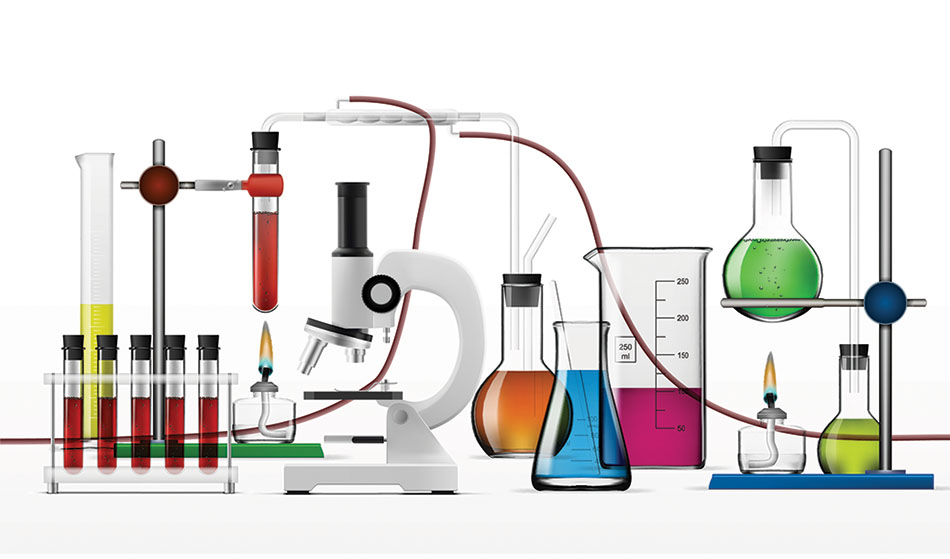
Vector Things / Shutterstock
Much of the analytical work performed by physical chemists requires the use of sophisticated instrumentation and equipment. This article will provide a brief overview of the analytical instruments that are commonly used in a physical chemistry laboratory.
What is Physical Chemistry?
Physical chemistry is primarily focused on investigating the behavior of matter on both a molecular and atomic scale. Additionally, physical chemists also examine how chemical reactions occur to determine the mechanisms by which complex structures are formed.
To make these discoveries, physical chemists use a variety of analytical instruments including lasers, mass spectrometers, nuclear magnetic resonance, and electronic microscopes.
Mass Spectrometers
Mass spectrometry (MS) is a widely used analytical chemistry tool that provides users with information on the amount and type of chemicals that may be present within a specific sample. This data on a given chemical compound will be determined by the abundance of gas-phase ions measured during the analysis, as well as by measuring the mass-to-charge ratio.
The ions signal, which is plotted as a function of the mass-to-charge ratio on the mass spectrum, can be used to determine the mass of the molecular ion. Fragments displayed on the mass spectrum can also contribute to the determination of the specific elemental or isotopic composition of the compound.
Within the field of physical chemistry, several different MS techniques are used to study the physicochemical characteristics of chemical compounds. For the identification of ambient particles, for example, researchers have confirmed the capabilities of several MS techniques that provide detailed information on the chemical transformations of particles and droplets that occur within the atmosphere. Some of these MS techniques include ambient surface ionization, secondary ion MS, (SIMS) secondary neutral MS (SNMS), laser desorption ionization MS and laser ablation MS (LA-MS).
Nuclear Magnetic Resonance
Nuclear magnetic resonance (NMR) instruments analyze chemical compounds and measure the interaction of nuclear spins that occur when the sample is placed in a powerful magnetic field. A typical NMR instrument includes a computer that controls the instrument and processes all collected data, a spectrometer that transmits and receives radio-frequency waves which are used to obtain the NMR measurements as well as a super-conducting magnet that creates the magnetic field that will ultimately generate and expose radio waves to the sample.
Many physical chemists will utilize NMR techniques to investigate the surface chemistry and physical properties of a wide range of substances. For example, a recent study published in Chemistry of Materials found that the capabilities of NMR to characterize the formation and composition of chemical compounds, as well as provide information on the chemical environments of constituent atomic nuclei, at the molecular level supports the use of this tool for the analysis of noble metal nanoparticle (NMNP) systems.
More specifically, these researchers found that NMR accurately analyzed the growth, surface chemistry and physical properties of several different NMNPs.
Electronic Microscopy
Electron microscopy (EM) is a family of high-resolution imaging techniques that allow users to visualize and investigate the detailed structure of a given sample of interest. Some of the most commonly used EM equipment that can be found in a physical chemistry laboratory includes a transmission electron microscope (TEM), scanning electron microscope (SEM) and reflection electron microscope (REM). TEM-related techniques, for example, have gained a significant amount of attention for their usefulness in identifying the surface features and reaction dynamics of a wide range of chemical compounds.
Sources
- “Physical Chemistry” – The American Chemical Society
- “Mass Spectrometry Fundamentals – Theory” – Agilent Technologies
- “NMR basic knowledge” – JEOL
- Laskin, J., Laskin, A., & Nizkordov, S. A. (2012). New mass spectrometry techniques for studying the physical chemistry of atmospheric heterogeneous processes. International Reviews in Physical chemistry 32; 128-170. DOI: 10.1080/0144235X.2012.752904.
- Marbella, L. E., & Millstone, J. E. (2015). NMR Techniques for Noble Metal Nanoparticles. Chemistry of Materials 27; 2721-2739. DOI: 10.1021/cm504809c.
- “Types of Electron Microscopes” – News-Medical.net
- Zhang, W., & Zheng, W. (2015). Transmission electron microscopy finds plenty of room on the surface. Physical Chemistry Chemical Physics 17; 14461-14469. DOI: 10.1039/C5CP01705J.
Disclaimer: The views expressed here are those of the author expressed in their private capacity and do not necessarily represent the views of AZoM.com Limited T/A AZoNetwork the owner and operator of this website. This disclaimer forms part of the Terms and conditions of use of this website.